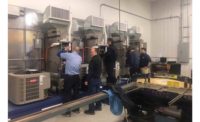Connected homes continue to grow in popularity, creating an opportunity for HVAC contractors to create an even stronger bond with homeowners. Of course, there are plenty of other providers who also want to gain access to this market. That’s why HVAC contractors need the right strategy and the right partners to succeed.
Jason Johnson, connected home program manager for Service Roundtable, said HVAC contractors have an advantage because they are already in the homes. Other providers are doing everything they can just to get in, even going so far as hiring people to knock on doors.

OPPORTUNITIES ABOUND: Jason Johnson tells HVAC contractors the need to provide connected home solutions to their customers. (File photo)
“They’re spending tons of money just to get inside the door,” Johnson said. “If you’re doing maintenance for a customer, they trust you.”
In many ways, HVAC is the ideal entry point for connected homes, said Jason Wilson, product manager of residential controls for Johnson Controls. It’s one of the biggest investments homeowners make and also accounts for about half of all utility bills. This means consumers are willing to spend for better management.
“Especially with more people working at home than ever before, homeowners are putting greater investment into home improvements and are looking for ways to increase connectivity and automation, while decreasing energy consumption without compromising on comfort,” Wilson said.
Connected home program manager, Service Roundtable
Young Homeowners Want Connectivity
Interest in connected home products will grow as more young people buy homes. The average homebuyers are in their early 30s. This means they’re digital natives who want this kind of technology. The challenge for contractors is how these people are learning about smart home devices. It’s mainly from friends and social media, rather than installers or even manufacturers.
HVAC contractors need to understand what consumers look for in connected home products. Brad Lucas, director of marketing, comfort control for Emerson, said they are looking for multiplatform compatibility, easy setup, and a top-rated mobile app, among other features. Emerson’s Sensi smart thermostats, for example, work with all major platforms, including Google Home, Alexa, Apple HomeKit, and SmartThings, meaning there is no bias to one platform. Johnson Controls just launched the Universal Thermostat Adapter, which allows homeowners and contractors the flexibility to utilize most third-party thermostats of their choice with York’s variable capacity systems.
Privacy is a large and growing concern for consumers. As larger smart home platforms enter this space, Lucas said, customers’ concerns around privacy are likely to increase.
“During a time when the news is full of more and more stories about data breaches, we think it is more important now than ever to protect data privacy by not selling personal information or utilizing thermostat activity for other targeting and/or advertising purposes,” he said. “This gives customers the confidence that they can upgrade to a smart thermostat without their personal information being misused.”
Promote Yourself Directly
Smart thermostats and apps can be a way for HVAC contractors to promote themselves simply by connecting their logo. They act as digital version of furnace stickers and refrigerator magnets — only they are even better, Johnson said, because consumers look at them on a regular basis.
For consumers, smart home products mean high tech. For HVAC contractors, smart home products mean low-voltage. A connect product, such as a smart thermostat, may seem like a challenge, but manufacturers make it fairly simple to install them. Emerson’s Sensi mobile app takes contractors and homeowners through a step-by-step guide for installation and setup, including a prompt to take a photo of the thermostat that is being replaced with old wiring setup so Emerson’s support team can provide technical support if needed. The app also provides guidance for configuration, wire connection, and Wi-Fi connection.
Connected homes allow HVAC contractors to better and more easily service their customers’ homes. Contractors are seeing value in platforms that allow for remote access and system diagnostics information, Wilson said. These features allow contractors to have valuable data in the palm of their hands adding to their uptime and efficiency.
More Devices Connect All the Time
Connected homes are here to stay. Wilson said that in the next four years, smart home adoption by homeowners will exponentially increase both through the introduction of new products as well as further education and organic interest by consumers. On average, smart home product users have nine smart devices in their home, ranging from speakers to light bulbs, switches, thermostats, doorbells, and and cameras. By 2025, Wilson said, it’s projected to be closer to 20 devices per home.

JOINING THE CLUB: Condair’s HumiLife whole-house humidifiers allows consumers to set humidity levels remotely. The number of devices that are part of the connected home ecosystem grows all the time. (Courtesy of Condair)
Connected devices are already gaining prevalence in the HVAC space. Condair now offer the HumiLife, a whole-home steam humidifier that homeowners control with an app.
“From there, you can control whatever the humidifier does,” said Samuel Spence, Condair’s marketing director.
Consumers can set the relative humidity level when they are away from home, Spence said. This helps with everything from creating a more comfortable space to ensuring a good living environment for house plants. Spence said connected homes are becoming part of a greater vision for homebuilders.
The main focus of that vision is creating peace of mind for homeowners. That’s another selling point for connected homes, Johnson said. For example, a contractor can install leak monitors. Not only does this ease the concerns of consumers, but it can even earn them a discount on their insurance policies.
That’s another force driving the move to connected homes. They help consumers feel better and save money on both energy costs and insurance. HVAC contractors can be a central part of this shift if they embrace it and market their services.








